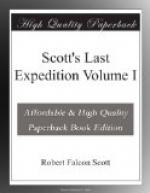There is not a vestige of swell, and with the wind in this direction there certainly ought to be if the open water was reasonably close. No, it looks as though we’d struck a streak of real bad luck; that fortune has determined to put every difficulty in our path. We have less than 300 tons of coal left in a ship that simply eats coal. It’s alarming—and then there are the ponies going steadily down hill in condition. The only encouragement is the persistence of open water to the east and south-east to south; big lanes of open water can be seen in that position, but we cannot get to them in this pressed up pack.
Atkinson has discovered a new tapeworm in the intestines of the Adelie penguin—a very tiny worm one-eighth of an inch in length with a propeller-shaped head.
A crumb of comfort comes on finding that we have not drifted to the eastward appreciably.
Friday, December 23.—The wind fell light at about ten last night and the ship swung round. Sail was set on the fore, and she pushed a few hundred yards to the north, but soon became jammed again. This brought us dead to windward of and close to a large berg with the wind steadily increasing. Not a very pleasant position, but also not one that caused much alarm. We set all sail, and with this help the ship slowly carried the pack round, pivoting on the berg until, as the pressure relieved, she slid out into the open water close to the berg. Here it was possible to ‘wear ship,’ and we saw a fair prospect of getting away to the east and afterwards south. Following the leads up we made excellent progress during the morning watch, and early in the forenoon turned south, and then south-west.
We had made 8 1/2’ S. 22 E. and about 5’ S.S.W. by 1 P.M., and could see a long lead of water to the south, cut off only by a broad strip of floe with many water holes in it: a composite floe. There was just a chance of getting through, but we have stuck half-way, advance and retreat equally impossible under sail alone. Steam has been ordered but will not be ready till near midnight. Shall we be out of the pack by Christmas Eve?
The floes to-day have been larger but thin and very sodden. There are extensive water pools showing in patches on the surface, and one notes some that run in line as though extending from cracks; also here and there close water-free cracks can be seen. Such floes might well be termed ‘composite’ floes, since they evidently consist of old floes which have been frozen together—the junction being concealed by more recent snow falls.
A month ago it would probably have been difficult to detect inequalities or differences in the nature of the parts of the floes, but now the younger ice has become waterlogged and is melting rapidly, hence the pools.
I am inclined to think that nearly all the large floes as well as many of the smaller ones are ‘composite,’ and this would seem to show that the cementing of two floes does not necessarily mean a line of weakness, provided the difference in the thickness of the cemented floes is not too great; of course, young ice or even a single season’s sea ice cannot become firmly attached to the thick old bay floes, and hence one finds these isolated even at this season of the year.




